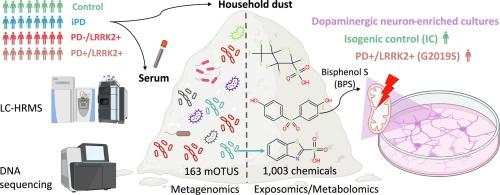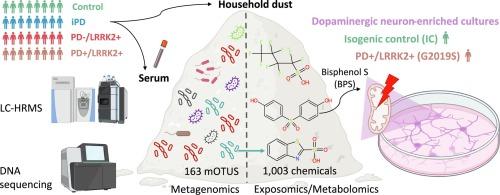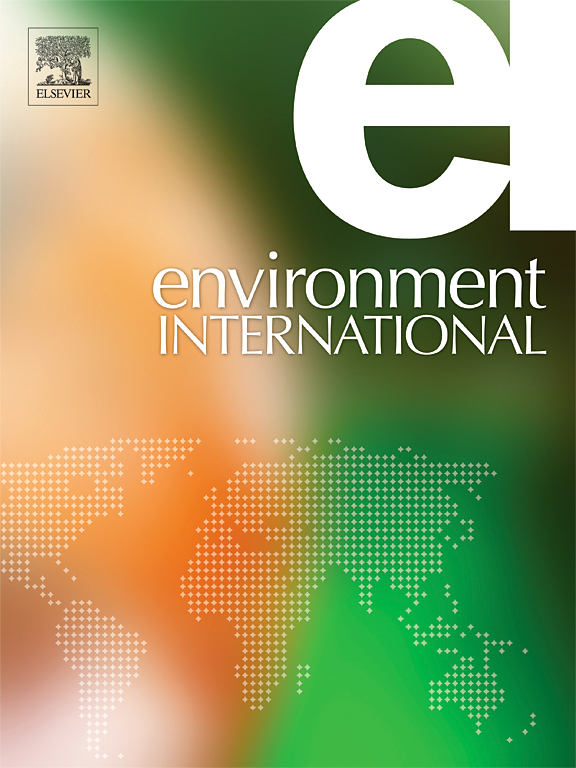探索 LRRK2 相关帕金森病渗透性的环境调节因素:关于家用灰尘的暴露组学和元基因组学试点研究
IF 10.3
1区 环境科学与生态学
Q1 ENVIRONMENTAL SCIENCES
引用次数: 0
摘要
富亮氨酸重复激酶 2(LRRK2)基因的致病变体是帕金森病(PD)的主要单基因病因。然而,遗传性LRRK2致病变体患帕金森病的可能性因年龄和地理区域等因素而异(这种现象被称为 "穿透力降低"),这凸显了生活方式和环境因素在发病中的潜在作用。为了研究这一点,我们采用代谢组学/暴露组学和元基因组学方法分析了四组不同人群的家庭灰尘样本:PD+/LRRK2+(具有致病性 LRRK2 变异的 PD 患者;n = 11)、PD-/LRRK2+(具有致病性 LRRK2 变异但未确诊为 PD 的个体;n = 8)、iPD(病因不明的 PD;n = 11)以及匹配的健康对照组(n = 11)。在有条件的情况下,还对匹配的血清样本进行了代谢组学和脂质组学分析。粉尘样本中共鉴定出 1,003 种化学物质和 163 个元基因组操作分类单元(mOTU),其中 90 种化学物质和 10 个元基因组操作分类单元具有统计学意义(方差分析 p 值为 0.05)。与 PD+/LRRK2 + 组相比,PD-/LRRK2 + 组的 2-苯并噻唑磺酸 (BThSO3) 含量降低。在灰尘中初步确定的重要化学物质中,有两种是危险化学替代品:双酚 S (BPS) 和全氟丁烷磺酸 (PFBuS)。此外,还发现血清中的各种脂质发生了变化,包括不同的溶血磷脂酰乙醇胺(LPEs)和溶血磷脂酰胆碱(LPCs),与对照组相比,PD+/LRRK2 + 组中某些脂质的含量更高。对PD+/LRRK2 +患者产生的同源神经元进行的细胞研究表明,BPS会对线粒体功能产生负面影响,而线粒体功能与PD的发病机制有关。这项试验性研究表明,对室内灰尘样本进行非目标代谢组学/暴露组学分析,并辅以元基因组学研究,可以优先确定可能成为 LRRK2 渗透性潜在修饰因子的相关化学物质。本文章由计算机程序翻译,如有差异,请以英文原文为准。


Exploring environmental modifiers of LRRK2-associated Parkinson’s disease penetrance: An exposomics and metagenomics pilot study on household dust
Pathogenic variants in the Leucine-rich repeat kinase 2 (LRRK2) gene are a primary monogenic cause of Parkinson’s disease (PD). However, the likelihood of developing PD with inherited LRRK2 pathogenic variants differs (a phenomenon known as “reduced penetrance”), with factors including age and geographic region, highlighting a potential role for lifestyle and environmental factors in disease onset. To investigate this, household dust samples from four different groups of individuals were analyzed using metabolomics/exposomics and metagenomics approaches: PD+/LRRK2+ (PD patients with pathogenic LRRK2 variants; n = 11), PD-/LRRK2+ (individuals with pathogenic LRRK2 variants but without PD diagnosis; n = 8), iPD (PD of unknown cause; n = 11), and a matched, healthy control group (n = 11). The dust was complemented with metabolomics and lipidomics of matched serum samples, where available. A total of 1,003 chemicals and 163 metagenomic operational taxonomic units (mOTUs) were identified in the dust samples, of which ninety chemicals and ten mOTUs were statistically significant (ANOVA p-value < 0.05). Reduced levels of 2-benzothiazolesulfonic acid (BThSO3) were found in the PD-/LRRK2+ group compared to the PD+/LRRK2+ . Among the significant chemicals tentatively identified in dust, two are hazardous chemical replacements: Bisphenol S (BPS), and perfluorobutane sulfonic acid (PFBuS). Furthermore, various lipids were found altered in serum including different lysophosphatidylethanolamines (LPEs), and lysophosphatidylcholines (LPCs), some with higher levels in the PD+/LRRK2+ group compared to the control group. A cellular study on isogenic neurons generated from a PD+/LRRK2+ patient demonstrated that BPS negatively impacts mitochondrial function, which is implicated in PD pathogenesis. This pilot study demonstrates how non-target metabolomics/exposomics analysis of indoor dust samples complemented with metagenomics can prioritize relevant chemicals that may be potential modifiers of LRRK2 penetrance.
求助全文
通过发布文献求助,成功后即可免费获取论文全文。
去求助
来源期刊

Environment International
环境科学-环境科学
CiteScore
21.90
自引率
3.40%
发文量
734
审稿时长
2.8 months
期刊介绍:
Environmental Health publishes manuscripts focusing on critical aspects of environmental and occupational medicine, including studies in toxicology and epidemiology, to illuminate the human health implications of exposure to environmental hazards. The journal adopts an open-access model and practices open peer review.
It caters to scientists and practitioners across all environmental science domains, directly or indirectly impacting human health and well-being. With a commitment to enhancing the prevention of environmentally-related health risks, Environmental Health serves as a public health journal for the community and scientists engaged in matters of public health significance concerning the environment.
 求助内容:
求助内容: 应助结果提醒方式:
应助结果提醒方式:


